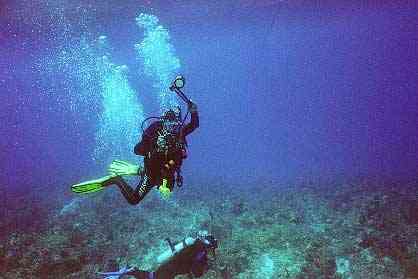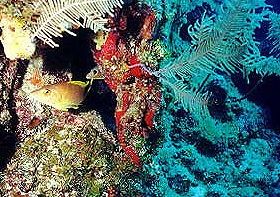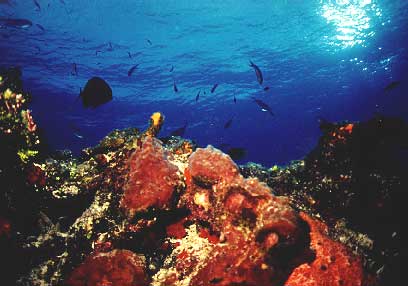DIVING 101
getting certified is easy and fun
Coral Reefs
Diving 101
Florida Marinas
Florida Boating
Artificial Reef Map with Links to Dive Shops (with FLASH 4 )
(Non Flash)
Just call me Jacques, as in Cousteau. I'm now one with the water. I'm now an underwater god. I'm now a certified scuba diver. I now want to tell anyone who will listen (or read this) that they could and should do the same somewhere in the Sunshine State, a scuba diving mecca.
If I can dive, anyone can dive. It's a simple sport to learn and something that can be pursued for life. Just dive right in.
Business and pleasure have often taken me to many exotic seaside locales in Florida. But, until recently, I've only enjoyed the land and very little of the surrounding sea. Thus, the desire to dive.
DIVING IN

This desire culminated in recently earning my "C-card," the certification card for open water divers. The largest certifying organization is the Professional Association of Diving Instructors (PADI). A piece of plastic from PADI (or one of many other agencies) means you can rent or buy scuba equipment, obtain air for tanks, and participate in other exciting diving activities throughout Florida (and the world). I'll never leave home without it.
The certification process is interesting and easy. It is divided into three parts, stretched over about thirty hours: classroom (using a book and visual aids), pool (confined water), and open water instruction. The classroom and pool sessions generally take place at the same time, while the open water dives (at least four of them) serve as the final test. The entire process can be completed over many weeks or packed into a few days at a sunny Florida vacation scuba school.
The basics of scuba diving are surprisingly simple. Divers use specialized modern equipment that adapts to the aquatic environment. Scuba equipment provides a portable air supply that allows divers to spend an extended time underwater (from a few minutes to several hours, depending on factors like depth and breathing efficiency).
The tank is a high-pressure cylinder that stores plain old compressed air--never oxygen--which i
 s released with a valve. This passes through a regulator to deliver a controlled amount of air when you inhale. A gauge lets you monitor the air supply.
s released with a valve. This passes through a regulator to deliver a controlled amount of air when you inhale. A gauge lets you monitor the air supply.The tank and regulator are typically held in place by a buoyancy control device (BCD), an expandable bladder that can be inflated or deflated to control a diver's buoyancy. The mask is the window to the underwater world, creating an air space which allows divers to see. A snorkel is attached to the mask and allows divers to breathe at the surface without having to lift their heads. Fins allow you to move through the water with little effort. A weight belt is also worn to allow you to sink.
The classroom time demystifies much of the stuff that tends to scare people about diving. You learn that diving is far less risky than skiing and that sunburn, and not a shark, is usually the greatest danger facing divers.
By the end of our first class, everyone was ready to hit the pool. The pool time was filled with a bunch of awkward underwater virgins banging into each other. I could see and feel a bit of anxiety in me and others.
By our third time in the pool, however, we looked like the Cousteau family exploring the pool for underwater treasure. During the pool sessions, we practiced breathing efficiently, removing and replacing our mask, buddy breathing (using another diver's breathing apparatus), removing and replacing our tanks, and much more.
The only thing you need to jump right in is good health, desire, and a reasonable comfort level with water. The pool sessions even turn out to be fun, as you learn new skills and develop confidence in your ability to have fun while getting all wet.
The open water dives are usually completed at a popular local dive site (Florida has hundreds), where all scuba skills are reviewed and tested. After passing a final written exam, you, too, can become an underwater god.

JUST DO IT
There are three general ways of getting certified. Everything can be completed locally. Another method is to complete the classroom and pool sessions locally and then complete the open water part on a warm-weather vacation. Or you can do everything at a vacation scuba school.
The Sunshine State makes it easy to get certified. Florida is known for great diving, with excellent conditions and lots of marine life. There are also hundreds of locations throughout the state for getting certified. Though there is great diving throughout the state, three dive destinations great for getting certified are the Florida Keys, Fort Lauderdale, and Destin.
The Divers Den in Key Largo provides a perfect place to learn to dive, with nearby John Pennekamp Underwater Park and adjacent Key Largo National Marine Sanctuary. They offer a complete certification course for about $300.00 and also have shops in Miami and Ft. Lauderdale.
Up in Ft. Lauderdale, wreck diving reigns as king of the seas. The area features beautiful diving on artificial reefs made from purposely-sunk ships. Professional Diving Schools of Florida offers a complete course for about $300.
Along the Panhandle, Destin's Fantasea Scuba Headquarters provides a great introduction to diving in the beautiful green waters of the Gulf of Mexico. Their certification course is about $200.
There are many other dive shops throughout the Sunshine State. Contact local shops or PADI and then dive right in.
Travel Notes
WHERE IT'S AT:

For a list of all PADI dive shops in Florida, contact them at 1251 East Dyer Rd., #100, Santa Ana, CA 92705, (714) 540-7234. In Key Largo, contact Divers Den at 102965 Overseas Highway (US 1), Mile Marker 103, Key Largo, FL 33037, (305) 451-DIVE or (800) 527-DIVE. In Ft.
Lauderdale, contact Professional Diving Schools of Florida, 801 Seabreeze Blvd., Ft. Lauderdale, FL 33316, (305) 761-3413. In Destin, contact Fantasea Scuba Headquarters, P.O. Box 5498, #1 Highway 98 East, Destin, FL 32540, (904) 837-0732 or (800) 326-2732.
WHAT IT COSTS
Open water certification courses in Florida can range from $150 to $400. This typically includes the cost of rental of most equipment needed. Most dive shops require students to purchase their own mask, fins, and snorkel for the course.